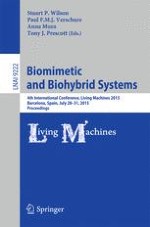2015 | Buch
Biomimetic and Biohybrid Systems
4th International Conference, Living Machines 2015, Barcelona, Spain, July 28 - 31, 2015, Proceedings
herausgegeben von: Stuart P. Wilson, Paul F.M.J. Verschure, Anna Mura, Tony J. Prescott
Verlag: Springer International Publishing
Buchreihe : Lecture Notes in Computer Science
